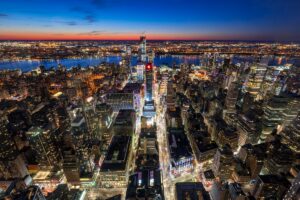There has been significant discussion surrounding the transformation of office spaces into residential properties in New York, accompanied by inquiries into the entities successfully executing these endeavors.
An analysis conducted by The Real Deal delved into alteration permits filed between 2022 and 2023, revealing the most substantial office-to-residential conversion projects.
The following are summaries of the five most notable ventures:
25 Water Street
Following the inauguration of Harry Macklowe’s One Wall Street in March, the mantle for the largest office-to-residential conversion in the country shifted to 25 Water Street. This project involves altering over 900,000 square feet of the building’s 1.1 million square feet. Formerly recognized as 4 New York Plaza, this 22-story office edifice previously housed notable occupants like the New York Daily News, American Media, and J.P. Morgan Chase. In the wake of the pandemic, these entities vacated the premises. The property was acquired by GFP Real Estate and Nathan Berman’s Metro Loft Management for $250 million in December. Their vision encompasses adding 10 additional floors and reimagining the interior to create open and well-lit spaces, including courtyards. Anticipated to yield around 1,200 rentals, the apartments will span from studios to four-bedroom units, accommodating approximately 50 residences on each floor. Certain units will feature 10-foot ceilings and dedicated home office spaces.
160 Water Street
The transformation of this 487,000-square-foot former office building in the Financial District is overseen by architecture firm Gensler. The project entails augmenting the existing 24-story structure by five floors. The resulting 586 rental units will enjoy access to shared amenities such as a rooftop terrace, gymnasium, co-working areas, dining spaces, a bowling alley, and a spa. The expansive redesign and expansion have secured financing through a $272.5 million loan from Brookfield Real Estate Financial Partners. Vanbarton Group, the developer, intends to reconfigure the building’s facade as part of the revitalization. Occupants are expected to begin moving in starting September 2024.
55 Broad Street
Located in proximity to the site of Lower Manhattan’s forthcoming tallest residential tower at 45 Broad Street, Silverstein Properties and Metro Loft Management are collaborating on the conversion of 55 Broad Street. This office building will be transformed into 571 market-rate rental units. The acquisition of the property, made in July from Rudin Management at a cost of $172.5 million, involved the former owner retaining a stake in the project. Recent permits filed in August have designated 49 Broad Street as the locus for a construction endeavor encompassing more than 400,000 square feet. This entails the addition of six stories to the existing 30-story structure. Among the amenities planned are a private club, fitness facilities, co-working spaces, and a rooftop pool featuring a landscaped sundeck and grilling area. The construction is slated to commence this month.
650 First Avenue
Acquired by Lalezarian Properties for $33.5 million on March 23, this eight-story office building in Murray Hill received the green light from the Department of Buildings for conversion into residential spaces. Upon completion, the property will encompass 23,000 square feet of commercial area and over 116,000 square feet of housing, according to official filings.
330 West 42nd Street
In Midtown, Resolution Real Estate is embarking on a significant undertaking involving the partial conversion of the McGraw-Hill Building at 330 West 42nd Street. As a designated city landmark with 33 stories and art deco architecture, the tower will witness the transformation of more than 560,000 square feet into 224 rental units. These units will span from studios to two-bedroom residences and will occupy floors 12 through 32. Notably, the renovation, totaling $100 million, will not impact office contracts; corporate lessees will continue to rent space on the lower floors. Prior to this overhaul, the owners expended $40 million to restore the building’s historic appearance, which included the removal of non-historical windows along one of the city’s prominent thoroughfares.



